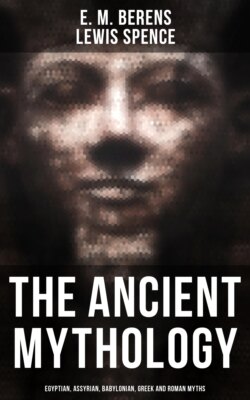Читать книгу The Ancient Mythology: Egyptian, Assyrian, Babylonian, Greek and Roman Myths - Lewis Spence - Страница 75
На сайте Литреса книга снята с продажи.
Nirig, or Enu-Restu
ОглавлениеThis deity is alluded to in an inscription as "the eldest of the gods." He was especially favoured by the Kings of Assyria, and we find his name entering into the composition of several of their texts. In a certain poem he is called the "son of Bel," and is described as being made "in the likeness of Anu." He rides, it is said, against the gods of his enemies in a chariot of lapis-lazuli, and his onset is full of the fury of the tempest. Bel, his father, commands him to set forth for the temple of Bel at Nippur. Here Nusku, the messenger of Bel, meets him, bestows a gift upon him, and humbly requests that he will not disturb the god Bel, his father, in his dwelling-place, nor terrify the earth-gods. It would appear from this passage that Nirig was on the point of taking the place of Bel, his father, but that he ever did so is improbable. As a deity of storm he is also a god of war, but he was the seed-scatterer upon the mountains, therefore he had also an agricultural significance. It is strange that in Babylonia tempest-gods possess the same functions and attributes—those of war and agriculture—as do rain or thunder, or rain-thunder, or wind and rain deities elsewhere-a circumstance which is eloquent of the power of climatic conditions in the manufacture of myth. In Mesopotamia fierce sand-storms must have given the people the idea of a savage and intractable deity, destructive rather than beneficent, as many hymns and kindred texts witness.
We have now briefly examined the elder gods of the Babylonian pantheon. Other, and in some cases more imposing, gods were yet to be adopted by the Babylonians, as we shall see in the following chapters.
1. The passage is quoted by kind permission of Messrs A. & C. Black.
2. Religious Belief in Babylonia and Assyria, p. 69.
3. Athenæum, Feb. 12, 1876.
4. Polyhistor is still speaking. The passage is somewhat obscure, and of course relates to the myth of Merodach and Tiawath—Bel representing Merodach, and "the woman-creature" Tiawath.
5. Religious Belief in Babylonia and Assyria, p. 88.
6. Religious Belief in Babylonia and Assyria, p. 81.
7. Religious Belief in Babylonia and Assyria, p. 82.
8. Elsewhere Ishtar herself is sprinkled. See p. 130.
9. Translation from Prof. Sayce's Hibbert Lectures, p. 157.
10. These deities of the underworld must not be confounded with the gods of the abyss referred to at great length in Chapter II. The first group are gods of the dead, the second gods of the primeval waters.
11. In sacrifice, too, the totemic or symbolic animal of the god is often flayed and the skin worn by the priest, who in this manner personates the god. In ancient Mexico the priests of Centeotl wore the skin of a woman sacrificed annually to that goddess.
